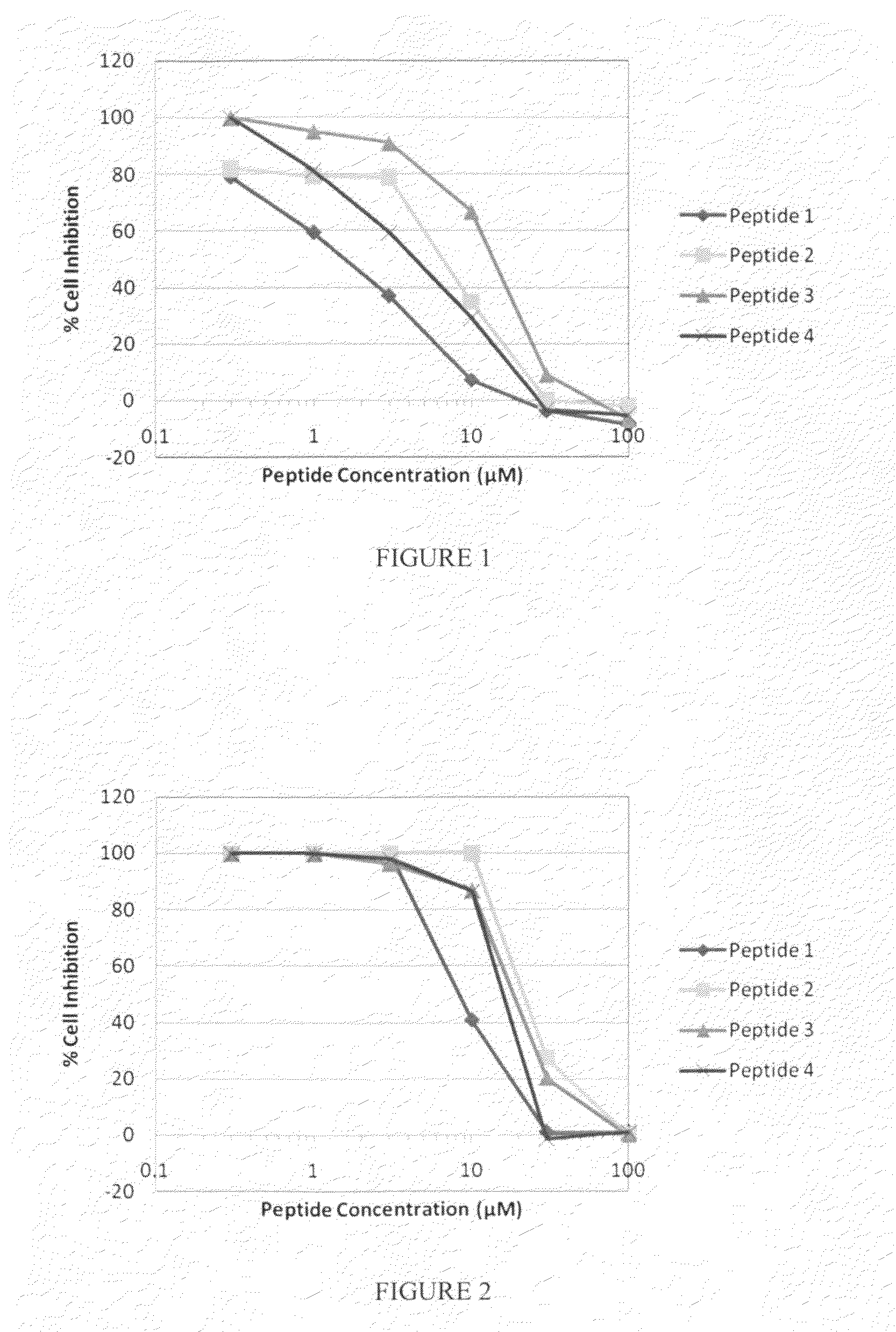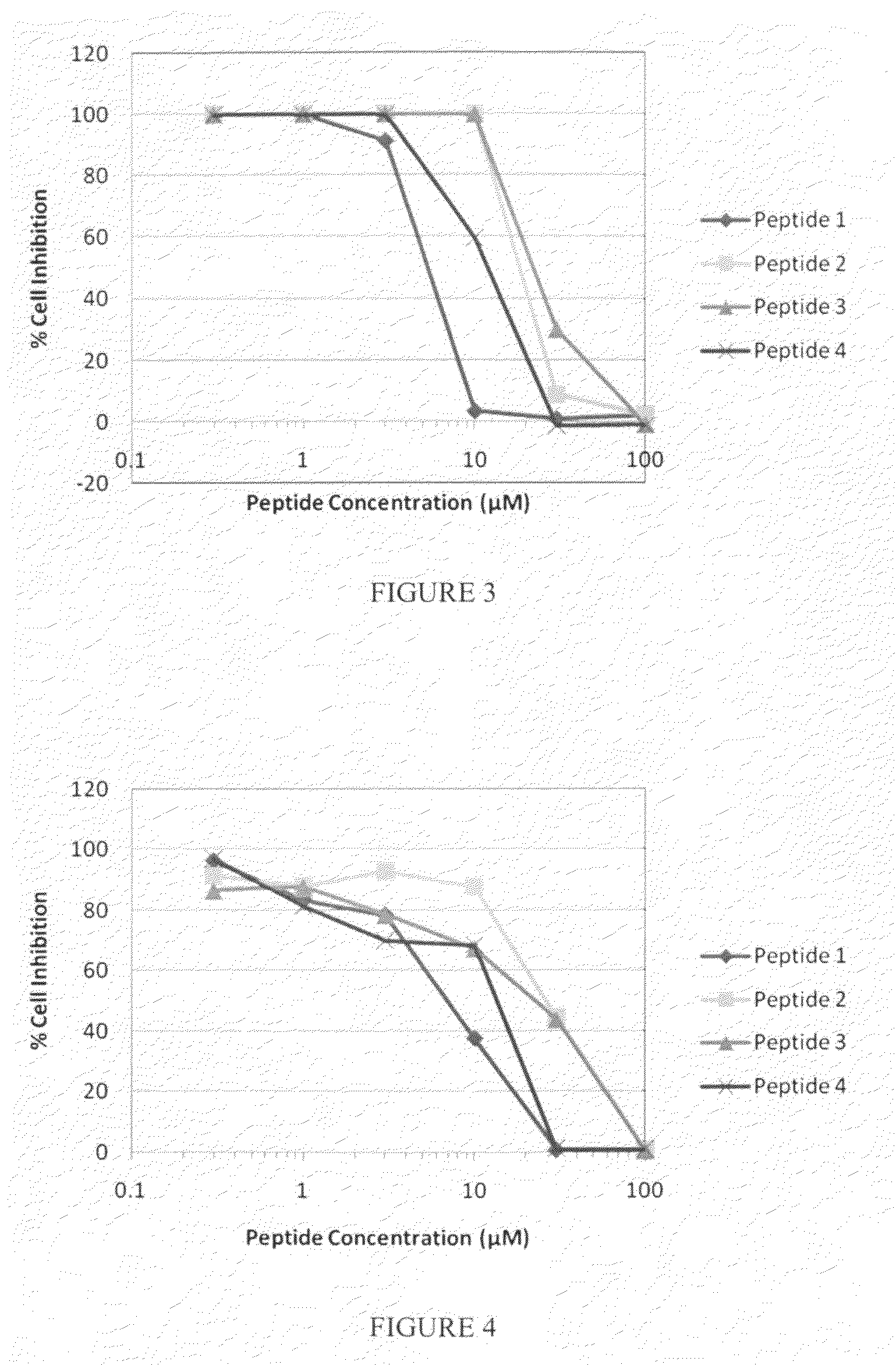Kinase Inhibitors And Uses Thereof
a kinase enzyme and enzyme technology, applied in the field of cell biology, can solve the problems of poor outcome in breast cancer, loss of differentiation, and reduced survival of drug resistant and drug sensitive multiple myeloma cells, and achieve the effects of inhibiting the growth of neoplasms, inhibiting the activity of kinase enzymes, and inhibiting hyperplasia
- Summary
- Abstract
- Description
- Claims
- Application Information
AI Technical Summary
Benefits of technology
Problems solved by technology
Method used
Image
Examples
example 1
Comparison of the Effectiveness of a Peptide Inhibitor of MAPKAP kinase II (MK2) Alone or Covalently Bound to the WLRRIKAWLRRIKA [SEQ ID NO: 134] Transduction Domain
[0202]Using the Omnia™ Lysate Assay for MAPKAP-K2 kit (Invitrogen, Carlsbad, Calif.), the reaction velocity for MK2 was determined in the presence and absence of each of the peptides listed in Table 2. Briefly, inhibitor peptide concentrations at 12.5 μmol, 25 μmol, 50 μmol and 100 μmol were evaluated. The kit contains a proprietary reaction buffer to which the following are added (final concentrations are given): 1 mM ATP, 0.2 mM DTT, 10 μM MAPKAP-K2 Sox-modified peptide substrate, 5 ng MK2, and the peptide inhibitor of interest (final volume of 50 μL). The reactions were performed in the wells of a low protein-binding 96-well plate provided with the kit, and fluorescence readings at 485 nm were taken every 30 seconds for 20 minutes in a Molecular Devices M5 Spectrophotometer. A peptide having the sequence KALNRQLGVAA [...
example 2
Transduction Domain Reaction Velocities
[0204]The MK2 inhibition activity of WLRRIKAWLRRIKA [SEQ ID NO: 134] transduction domain was compared with the MK2 inhibition activity of other known transduction domains—YARAAARQARA [SEQ ID NO: 135] and YGRKKKRRQRRR [SEQ ID NO: 136]. The transduction domains were tested for MK2 activity using the same assay conditions as Example 1. The results are shown in Table 4.
TABLE 4Reaction Velocities for DifferentTransduction Domains (n = 3)% of KKKALNRQLGVAA[SEQ ID NO: 115][SEQReaction Velocity atPeptideIDan Inhibitor ConcentrationSequenceNO:]of 100 μM (+ / −SEM*)WLRRIKA137394% (+ / −5%)WLRRIKAWLRRIKA134 19% (+ / −2%)YARAAARQARA135274% (+ / −9%)YGRKKRRQRRR136158% (+ / −11%)*SEM = Standard Error of the Mean for three values
[0205]These results indicate substantial differences in the effect of several transduction domains on inhibiting MK2 and that transduction domains are useful to inhibit the activity of kinases, such as MK2. The WLRRIKA [SEQ ID NO: 137] monomer ...
example 3
MK2 Inhibitor Peptides with Transduction Domains
[0206]A set of MK2 inhibitor peptides having transduction domains was synthesized (see Table 5). Variants included peptides with the WLRRIKAWLRRIKA [SEQ ID NO: 134] transduction domain and alanine substituted for asparagine, alanine substituted for glycine, or both alanine substitutions in the therapeutic domain. The same peptides with the YARAAARQARA [SEQ ID NO: 135] transduction domain also were prepared. The reaction velocities of these variants were compared to the reaction velocity of a blank with no inhibitor added. Results are shown in Table 6. The data in Table 6 shows a synergy between the transduction domain and the therapeutic domain in inhibiting MK2. Since the WLRRIKAWLRRIKA [SEQ ID NO: 134] transduction domain is a much stronger inhibitor of MK2 than the YARAAARQARA [SEQ ID NO: 135] transduction domain, peptides with a WLRRIKAWLRRIKA [SEQ ID NO: 134] transduction domain are much stronger inhibitors of MK2 at a given conce...
PUM
| Property | Measurement | Unit |
|---|---|---|
| hydrophobic | aaaaa | aaaaa |
| width | aaaaa | aaaaa |
| structure | aaaaa | aaaaa |
Abstract
Description
Claims
Application Information
 Login to View More
Login to View More - R&D
- Intellectual Property
- Life Sciences
- Materials
- Tech Scout
- Unparalleled Data Quality
- Higher Quality Content
- 60% Fewer Hallucinations
Browse by: Latest US Patents, China's latest patents, Technical Efficacy Thesaurus, Application Domain, Technology Topic, Popular Technical Reports.
© 2025 PatSnap. All rights reserved.Legal|Privacy policy|Modern Slavery Act Transparency Statement|Sitemap|About US| Contact US: help@patsnap.com



